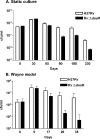The enduring hypoxic response of Mycobacterium tuberculosis
- PMID: 18231589
- PMCID: PMC2198943
- DOI: 10.1371/journal.pone.0001502
The enduring hypoxic response of Mycobacterium tuberculosis
Abstract
Background: A significant body of evidence accumulated over the last century suggests a link between hypoxic microenvironments within the infected host and the latent phase of tuberculosis. Studies to test this correlation have identified the M. tuberculosis initial hypoxic response, controlled by the two-component response regulator DosR. The initial hypoxic response is completely blocked in a dosR deletion mutant.
Methodology/principal findings: We show here that a dosR deletion mutant enters bacteriostasis in response to in vitro hypoxia with only a relatively mild decrease in viability. In the murine infection model, the phenotype of the mutant was indistinguishable from that of the parent strain. These results suggested that additional genes may be essential for entry into and maintenance of bacteriostasis. Detailed microarray analysis of oxygen starved cultures revealed that DosR regulon induction is transient, with induction of nearly half the genes returning to baseline within 24 hours. In addition, a larger, sustained wave of gene expression follows the DosR-mediated initial hypoxic response. This Enduring Hypoxic Response (EHR) consists of 230 genes significantly induced at four and seven days of hypoxia but not at initial time points. These genes include a surprising number of transcriptional regulators that could control the program of bacteriostasis. We found that the EHR is independent of the DosR-mediated initial hypoxic response, as EHR expression is virtually unaltered in the dosR mutant.
Conclusions/significance: Our results suggest a reassessment of the role of DosR and the initial hypoxic response in MTB physiology. Instead of a primary role in survival of hypoxia induced bacteriostasis, DosR may regulate a response that is largely optional in vitro and in mouse infections. Analysis of the EHR should help elucidate the key regulatory factors and enzymatic machinery exploited by M. tuberculosis for long-term bacteriostasis in the face of oxygen deprivation.
Conflict of interest statement
Figures




References
-
- Lillebaek T, Dirksen A, Baess I, Strunge B, Thomsen VO, et al. Molecular evidence of endogenous reactivation of Mycobacterium tuberculosis after 33 years of latent infection. J Infect Dis. 2002;185:401–404. - PubMed
-
- Parrish NM, Dick JD, Bishai WR. Mechanisms of latency in Mycobacterium tuberculosis. Trends Microbiol. 1998;6:107–112. - PubMed
-
- Corbett EL, Watt CJ, Walker N, Maher D, Williams BG, et al. The growing burden of tuberculosis: global trends and interactions with the HIV epidemic. Arch Intern Med. 2003;163:1009–1021. - PubMed
-
- Dye C. Global epidemiology of tuberculosis. Lancet. 2006;367:938–940. - PubMed
-
- Sweany HC, Cook CE, Kegerreis R. A study on the position of primary cavities in pulmonary tuberculosis. Am Rev Tuberc. 1931;24:558–582.
Publication types
MeSH terms
Grants and funding
LinkOut - more resources
Full Text Sources
Other Literature Sources
Molecular Biology Databases

